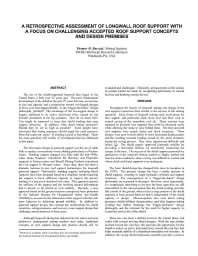Mining Publication: A Retrospective Assessment of Longwall Roof Support with a Focus on Challenging Accepted Roof Support Concepts and Design Premises
Original creation date: August 2006
Authors: TM Barczak
NIOSHTIC2 Number: 20030811
Proceedings of 25th International Conference on Ground Control in Mining, August 1-3, 2006, Morgantown, West Virginia. Peng SS, Mark C, Finfinger G, Tadolini S, Khair AW, Heasley K, Luo Y, eds., Morgantown, WV: West Virginia University, 2006 Aug; :232-244
The era of the shield-supported longwall face began in the United States a little over 25 years ago. The most fundamental development of the shield in the past 25 years has been an increase in size and capacity and a progression toward two-legged designs in favor over four-legged shields. Is the "bigger-the-better" design philosophy justified? The advantage of the two-legged design is largely attributed to its active horizontal force caused by the forward orientation of the leg cylinders. How do we know this? You might be surprised to learn that shield loading data may suggest otherwise. In addition, what about setting pressures? Should they be set as high as possible? Some people have advocated that setting pressures should equal the yield pressure. Does this make any sense? Is yielding a good or bad thing? These are some questions still worthy of investigation that are addressed in this paper. The first major change in gateroad support was the use of cable bolts to replace conventional wood cribbing particularly in Western mines. Standing support changed very little until the mid-1990s, when Strata Products introduced the Hercules and Propsetter supports in Eastern mines and Burrell Mining Products introduced the Can support in Western mines. Since then, there has been a dramatic increase in new roof support technologies for longwall gateroad support. Historically, standing support, including shield supports, have been designed based on a simplistic model requiring the support to have sufficient capacity to support the gravity loading of a perceived detached rock mass. This approach ignores the stiffness of the support and the resulting ground deformation that is known to be critical to roof stability. Recently, a new approach based on the ground reaction concept has been promoted by the National Institute for Occupational Safety and Health (NIOSH) to account for the interaction of the support with the rock mass behavior in achieving ground stability. In addition to gateroad support design, this concept has ramifications for shield capacities, setting pressures, and recovery room support design that challenge current practices in these areas. Although longwall mining has matured into the safest and most productive underground mining method used today, traditional concepts of roof support design and practice should still be evaluated and challenged. Ultimately, advancements in the science of ground control are made by recognizing deficiencies in current theories and thinking outside the box.

NIOSHTIC2 Number: 20030811
Proceedings of 25th International Conference on Ground Control in Mining, August 1-3, 2006, Morgantown, West Virginia. Peng SS, Mark C, Finfinger G, Tadolini S, Khair AW, Heasley K, Luo Y, eds., Morgantown, WV: West Virginia University, 2006 Aug; :232-244
- Analysis and Design Considerations for Superimposed Longwall Gate Roads
- Diagnosing and Controlling Moisture-Sensitive Roof in Coal Mines
- The Impact of Ground Control Research on the Safety of Underground Coal Miners: 1910-2010
- Longwall Shield and Standing Gateroad Support Designs - Is Bigger Better?
- Optimizing Secondary Roof Support with the NIOSH Support Technology Optimization Program (STOP)
- Overview of Coal Mine Ground Control Issues in the Illinois Basin
- Overview of Current US Longwall Gateroad Support Practices: An Update
- Pillar and Roof Span Design Guidelines for Underground Stone Mines
- Technology News 482 - Ground Support Safety Training Video
- Updating the NIOSH Support Technology Optimization Program (STOP) With New Support Technologies and Additional Design Features